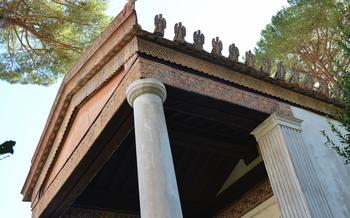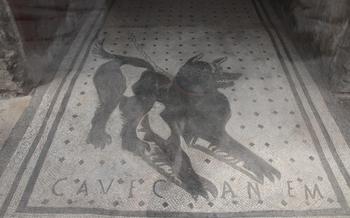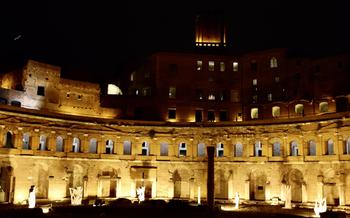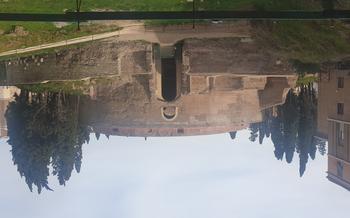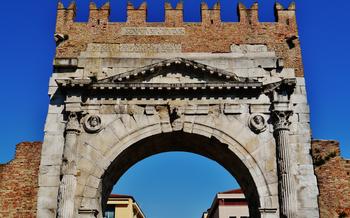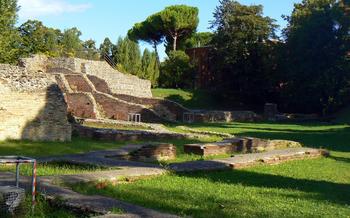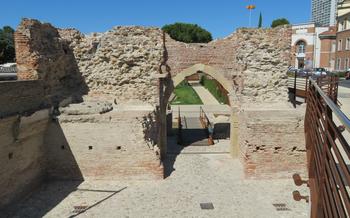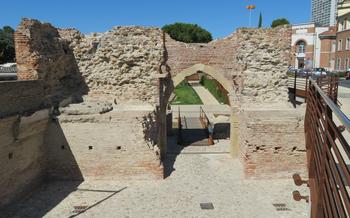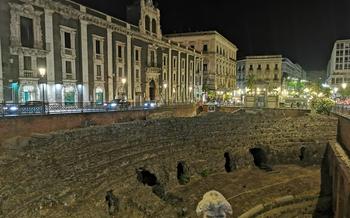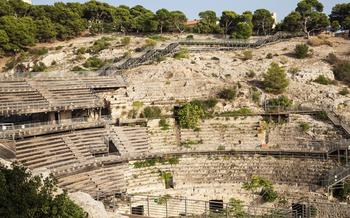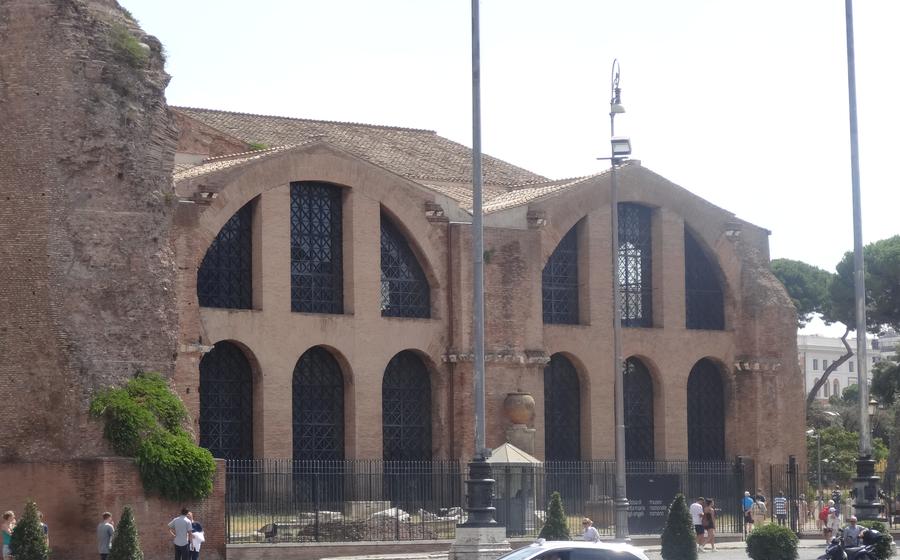
Baths of Diocletian
- Introduction
- History of the Baths of Diocletian
- Layout of the Baths of Diocletian
- The Caldarium (Hot Bath)
- The Tepidarium (Warm Bath)
- The Frigidarium (Cold Bath)
- The Natatio (Swimming Pool)
- The Libraries
- The Gymnasia
- The Gardens
- Restoration and Conservation
- Unique Features of the Baths of Diocletian
- Visiting the Baths of Diocletian
- Tips for Visiting the Baths of Diocletian
- Insider Tip: Unveil the Hidden Secrets
Introduction
The Baths of Diocletian stand as awe-inspiring testaments to the grandeur of ancient Rome. Commissioned by Emperor Diocletian in the late 3rd century AD, these colossal baths were not merely places of ablution but also symbols of imperial power and cultural significance. With their impressive architectural design and intricate mosaics, the Baths of Diocletian served as a sanctuary for relaxation, socialization, and intellectual pursuits, leaving an indelible mark on the fabric of Roman society. As you step through the gates of this magnificent complex, prepare to be transported back in time and immersed in the history, splendor, and majesty of ancient Rome.
History of the Baths of Diocletian
The Baths of Diocletian were commissioned by Emperor Diocletian in 298 AD and completed in 306 AD. They were the largest public baths in ancient Rome, measuring an impressive 1300 by 370 feet (400 by 113 meters). The baths were designed to accommodate thousands of bathers and served as a place for relaxation, socialization, and physical activity.
The baths were built on the grounds of the former Gardens of Sallust, a popular retreat for wealthy Romans. Diocletian chose this location for its proximity to the city center and its access to water from the nearby Aqua Marcia aqueduct.
The construction of the baths was a massive undertaking, requiring the labor of thousands of workers. The baths were built using a variety of materials, including brick, concrete, and marble. The exterior walls were adorned with intricate carvings and sculptures, while the interior was decorated with colorful mosaics and paintings.
The Baths of Diocletian were a marvel of ancient engineering and were considered one of the most impressive public buildings in Rome. They were a symbol of the power and prestige of the Roman Empire and were enjoyed by citizens of all social classes.
Layout of the Baths of Diocletian
The Baths of Diocletian were a massive complex that spanned several hectares and included multiple sections. The main bathing areas were divided into three sections: the caldarium (hot bath), the tepidarium (warm bath), and the frigidarium (cold bath). Each of these rooms served a specific purpose and was decorated accordingly. The caldarium was the hottest room and featured a central heating system that kept the temperature constant. The tepidarium served as a transitional room between the caldarium and the frigidarium and was used for acclimatizing the body to the temperature changes. The frigidarium was the coldest room and was used for cooling down after the hot baths.
In addition to the bathing areas, the baths also included other amenities such as gymnasia, libraries, and gardens. The gymnasia were used for exercise and physical fitness and included running tracks, wrestling areas, and weightlifting rooms. The libraries contained a vast collection of books and were used by scholars and philosophers. The gardens were extensive and used for relaxation and leisure and were adorned with sculptures and fountains.
The Caldarium (Hot Bath)
The centerpiece of the Baths of Diocletian was the caldarium, the hot bath. It was the warmest room in the complex, reaching temperatures of up to 40 degrees Celsius (104 degrees Fahrenheit). The caldarium was equipped with a sophisticated central heating system, consisting of a series of underground furnaces that circulated hot air through the walls and floors. Bathers would relax in the warm, steamy atmosphere of the caldarium, letting the heat penetrate their muscles and soothe their aching joints. The room was also used for bathing, with large pools of hot water available for immersion. The caldarium was a place of relaxation and rejuvenation, a place to escape the stresses of everyday life and indulge in the pleasures of the bath.
The Tepidarium (Warm Bath)
The tepidarium served as a transitional room between the scorching caldarium and the frigidarium. It allowed bathers to acclimatize their bodies gradually, preventing the shock of moving from one extreme temperature to another. The mosaics that adorn the tepidarium are particularly noteworthy, featuring intricate geometric patterns and vibrant colors. These mosaics not only add to the aesthetic appeal of the room but also provide valuable insights into the artistic styles and techniques of the time.
The Frigidarium (Cold Bath)
The frigidarium, or cold bath, was the coldest room in the baths. The frigidarium served as a way to cool down and help close the pores after exiting the hot bath. Here, bathers would plunge into a large pool of cold water. This helped circulate blood, relaxed tense muscles, and was thought to improve overall health and well-being. The frigidarium was often decorated with mosaics and paintings depicting scenes of nature or mythology. Statues representing river gods and nymphs were also often found in the frigidarium, symbolizing the cleansing and refreshing properties of cold water.
The frigidarium was an essential part of the bathing ritual in ancient Roman baths. It helped to balance the effects of the hot and warm baths and was believed to promote physical and mental well-being. Even today, many modern spas and bathhouses incorporate cold plunge pools into their facilities, recognizing the benefits of alternating between hot and cold water for relaxation and rejuvenation.
The Natatio (Swimming Pool)
Among the various bathing areas within the Baths of Diocletian, the Natatio stands out as a unique and refreshing feature. It was a large outdoor swimming pool, designed not only for relaxation but also for exercise and recreation. The Natatio was a crucial part of the Roman bathing culture, as swimming was considered an essential skill and a form of physical fitness.
This magnificent pool was situated in the center of the baths, surrounded by lush gardens that provided a serene and picturesque backdrop. Its vast dimensions allowed for ample space for swimmers to glide through the cool waters, practice strokes, or simply float and relax. The Natatio also served as a venue for swimming competitions and demonstrations, showcasing the athletic prowess of the Roman citizens.
Today, visitors to the Baths of Diocletian can still marvel at the remains of the Natatio, although it is no longer filled with water. The surrounding gardens have been carefully restored, offering visitors a glimpse into the tranquil ambiance of this ancient swimming pool.
The Libraries
Within the vast complex of the Baths of Diocletian, two libraries stood as repositories of knowledge and wisdom. These libraries housed a remarkable collection of books, scrolls, and manuscripts, covering various subjects such as philosophy, history, literature, and science. They served as centers of learning and research for scholars, philosophers, and students seeking to expand their knowledge and understanding.
The libraries were meticulously organized and maintained, with books arranged in shelves or stacked in niches. Skilled librarians managed the collection, ensuring its preservation and accessibility to those entitled to use it. The atmosphere within the libraries was one of quiet contemplation and intellectual pursuit, conducive to the exchange of ideas and the pursuit of knowledge.
The libraries of the Baths of Diocletian played a significant role in preserving and disseminating knowledge in ancient Rome. They were places where scholars and thinkers could gather, engage in discussions, and contribute to the advancement of learning and scholarship. The legacy of these libraries lives on, as they continue to inspire and inform generations of scholars and researchers to this day.
The Gymnasia
Within the vast complex of the Baths of Diocletian, dedicated spaces were reserved for physical exercise and athletic pursuits. These areas, known as gymnasia, played a crucial role in Roman society, where physical fitness and well-being were highly valued.
The gymnasia within the Baths of Diocletian were equipped with a range of facilities to cater to the diverse needs of bathers. Running tracks, wrestling areas, and weightlifting rooms provided ample opportunities for citizens to engage in various forms of exercise and improve their physical prowess.
The running tracks were likely used for both training and recreational purposes. Athletes could hone their speed and endurance by sprinting around the tracks, while others could enjoy a leisurely jog or walk for exercise. The wrestling areas offered a space for individuals to engage in friendly competitions or practice their combat skills.
The weightlifting rooms, equipped with a variety of weights and barbells, allowed bathers to build strength and muscle mass. These rooms were particularly popular among young men who aspired to develop a strong and athletic physique.
Beyond their primary function as exercise facilities, the gymnasia also served as social spaces where people could interact, socialize, and exchange ideas. After a strenuous workout, bathers could relax and unwind in the adjacent baths, enjoying the warm waters and engaging in conversation with fellow patrons.
The gymnasia within the Baths of Diocletian were not merely places for physical training but also hubs of social interaction and community engagement, reflecting the holistic approach to well-being that was characteristic of ancient Roman culture.
The Gardens
One of the most delightful features of the Baths of Diocletian was its extensive gardens. These beautifully landscaped areas provided a tranquil retreat where bathers could relax and socialize after their bathing rituals. The gardens were adorned with sculptures, fountains, and a variety of plants and flowers, creating a serene and picturesque environment.
The gardens were designed to complement the overall architectural style of the baths, featuring a combination of formal and informal planting. Formal gardens, characterized by geometric patterns and manicured hedges, were interspersed with more natural, naturalistic areas, creating a sense of harmony and balance.
The gardens also served a practical purpose, providing fresh air and shade to the bathers. The trees and plants helped to regulate the temperature and humidity within the complex, creating a more comfortable environment for bathing and relaxation.
Today, visitors to the Baths of Diocletian can still enjoy the beauty of the gardens. Although some of the original plantings have been lost over time, the gardens have been carefully restored and maintained to preserve their original charm and character.
Restoration and Conservation
Over the centuries, the Baths of Diocletian have undergone extensive restoration and conservation efforts to preserve their grandeur and historical significance. The restoration process aimed to maintain the original structures and mosaics, restoring them to their former glory. The baths' iconic architecture, including the massive domes and vaults, has been carefully restored to showcase the engineering brilliance of ancient Rome. Conservation efforts have also focused on preserving the intricate mosaic floors and wall paintings that adorn the various rooms, ensuring that future generations can appreciate the artistic masterpieces that once adorned this ancient bathing complex. The ongoing restoration and conservation projects are a testament to the enduring legacy of the Baths of Diocletian and the importance of preserving their cultural heritage for generations to come.
Unique Features of the Baths of Diocletian
The Baths of Diocletian were not just a place for bathing and relaxation but also a remarkable architectural and cultural achievement. Here are some of their most distinctive features:
Size and Scale: The Baths of Diocletian were the largest public baths in ancient Rome, covering an area of over 130,000 square meters. They could accommodate up to 3,000 bathers simultaneously.
Central Heating System: The baths employed a sophisticated central heating system called a hypocaust, which circulated hot air beneath the floors and walls. This advanced technology allowed for efficient and controlled heating, making the baths a comfortable and inviting space.
Libraries: The Baths of Diocletian boasted two libraries, a unique feature among Roman baths. These libraries housed an extensive collection of books on various subjects, catering to the intellectual and cultural pursuits of visitors.
Gardens: The baths were surrounded by extensive gardens adorned with fountains, sculptures, and shaded walkways. Visitors could stroll through these gardens, enjoying the fresh air and tranquil environment.
Architectural Innovations: The baths showcased several innovative architectural features, including large domes and vaulted ceilings. These structures demonstrated the advanced engineering skills of the Romans and added to the grandeur of the complex.
Visiting the Baths of Diocletian
Visiting the Baths of Diocletian is a unique and unforgettable experience. Located conveniently near Termini train station, the baths are easily accessible by public transport. To make the most of your visit, consider booking a guided tour to delve deeper into the history and architecture of this ancient wonder.
Combining a visit to the Baths of Diocletian with other nearby attractions such as the National Museum of Rome or the Basilica of Santa Maria Maggiore can create a well-rounded cultural itinerary. Keep an eye out for special events and exhibitions that often take place within the baths, offering visitors a chance to experience the space in a new light.
Tips for Visiting the Baths of Diocletian
To make the most of your visit to the Baths of Diocletian, consider the following tips:
-
Roma Pass: If you plan on visiting multiple attractions in Rome, consider purchasing a Roma Pass. This pass offers discounted admission to many popular attractions, including the Baths of Diocletian, as well as unlimited access to public transportation.
-
Comfortable Shoes: Wear comfortable shoes as there is a lot of walking involved in exploring the Baths of Diocletian. The complex is vast, and you'll want to be able to walk comfortably to see all the different sections.
-
Snacks and Water: Bring water and snacks with you, as there are limited food options within the baths. This will help you stay hydrated and energized throughout your visit.
-
Time: Allow ample time to explore the entire complex. The Baths of Diocletian are vast, and there is much to see. Plan to spend at least two hours exploring the different sections, including the main bathing areas, libraries, and gardens.
Insider Tip: Unveil the Hidden Secrets
To fully savor the essence of the Baths of Diocletian, steer clear of the throngs of tourists by opting for a visit during off-peak hours. This strategic move will not only grant you the tranquility to explore the complex at your own pace, but it will also unveil hidden corners and details that often go unnoticed amidst the hustle and bustle. As you wander through the sprawling chambers, let your imagination transport you back in time to an era when these grand baths were a vibrant hub of activity. Picture the echoes of laughter and chatter reverberating through the halls as ancient Romans indulged in their daily rituals of bathing, socializing, and seeking intellectual pursuits. Take a moment to admire the intricate mosaics and sculptures that adorn the walls and floors, each piece narrating a chapter in the rich history of this architectural masterpiece. Allow yourself to be captivated by the sheer grandeur of the Baths of Diocletian, a testament to the ingenuity and artistry of ancient Rome.
